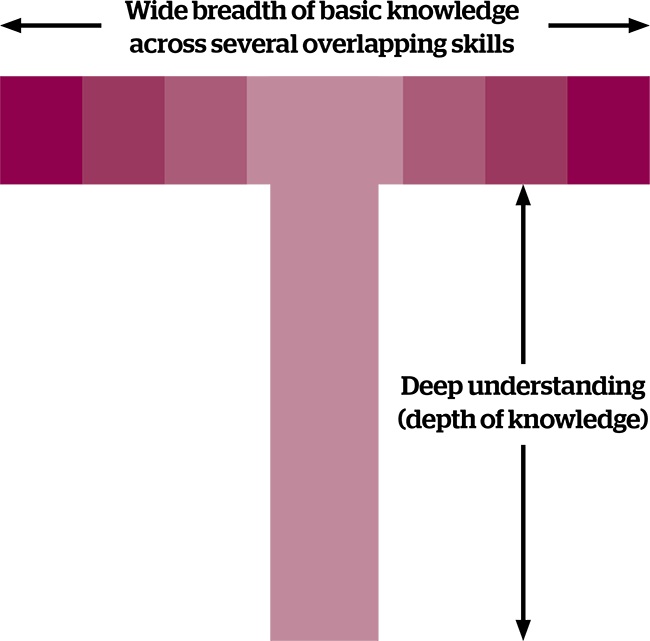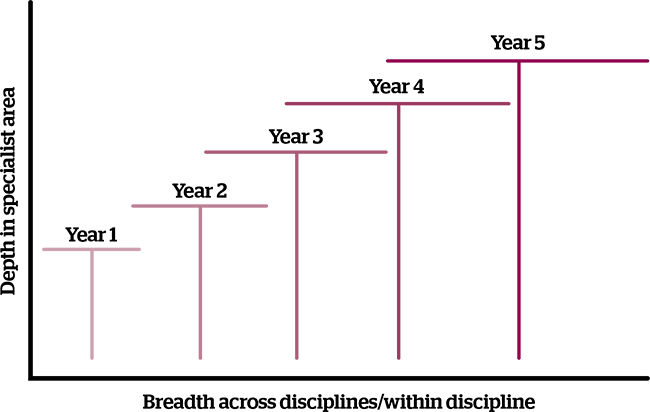9 Mar 2021
The concept of T-shaped skills is a metaphor often used by recruiters to describe the abilities of persons in the workforce. It is also an excellent framework to plan a veterinary CPD programme that’s going to deliver plenty of bang for your bucks…

Image © fizkes / Adobe Stock

Where will you be in your career this time next year or, for that matter, in five years?
Time was when most of us would be able to answer this with at least a hint of confident expectation, barring freaks of nature… or pandemics. What the past 12 months have surely shown is that the world is a very uncertain place. This may lead to you wondering what impact this uncertainty will have on your plans for personal and professional development within veterinary practice.
External factors you do not get to choose are present in every walk of life. You cannot control them, and it is wasted energy to try. But you can prepare for them by becoming as adaptable and flexible as possible. Key to adaptability and flexibility, certainly where a professional career is concerned, is a commitment to lifelong learning. So, how can you plan your CPD to prepare for uncertain times, changes within the industry and the wider economy that the future may present?
Enter the idea of the T-shaped vet/vet nurse. The T-shape is a metaphor used in recruitment to describe the skills of people in the workforce. The stem of the T represents deep knowledge/skills in one area, whereas the horizontal bar is the ability to develop a broad range of supporting knowledge/skills and to collaborate across disciplines (Figure 1).

Planning your CPD to develop a T-shaped skill set over time will bring benefits, both personally and professionally. You will experience the satisfaction of diving deep into one specialist subject area. This is likely to be rewarding to your career progression and contribution to your practice.
At the same time, you will become a better collaborator thanks to your broad base of knowledge. You will be better able to communicate with specialists in other fields. This will open up exciting possibilities for inter-professional learning. Variety is key to keeping your mind engaged and as a T-shaped person, you can still dip into other areas to get a break.
Most importantly, in the current climate, a T-shaped approach to CPD, and your career, will build a capacity for retraining and reinvention. Becoming more T-shaped will make you more flexible, adaptable, resilient and, ultimately, more employable.
So, how can you ensure your CPD enables you to become more T-shaped? Start by creating a personal skills inventory. Assess the skills and knowledge you already have, then rate yourself in each using a scale of 0-5: 0 (no knowledge/skills), 1 (novice), 2 (advanced beginner), 3 (competent), 4 (proficient), 5 (expert/to an outsider you look like a pro).
An honest self-assessment will enable you to decide where you want to improve your knowledge (0-2). It will also highlight the areas in which you are comfortable, but wish to maintain, rather than improve (3-5). Next, consider which skills you want to add and where you want/need to go deep.
The stem of your T is likely to be an existing area, but it may not be. Identify this deep area so you can focus on it. Choose something that fascinates you.
When it comes to the horizontal bar, resist the urge to let your veterinary qualification limit your ideas and opportunities. This is not, in any way, to suggest that a veterinary/nursing qualification isn’t a fantastic thing to have, but these uncertain times present the opportunity to think more creatively.
The choice of diverse learning opportunities through which you can develop both hard and soft transferable skills has never been greater. The shift to remote learning makes these types of courses more readily available and financially viable. CPD relating to disciplines such as education, law, personal growth and human medicine can be relevant to your current role, but will also broaden your horizons and increase your flexibility.
If you are a small animal clinician, perhaps now is the time to start adding large animal skills and knowledge to your repertoire? Equally, business skills CPD in marketing/sales/HR/finance will help grow the horizontal bar and open up more potential opportunities in the future.
When planning your CPD, you will need to decide how quickly you want to develop your desired T-shape. This will be determined not only by your career goals, but also by constraints such as time, finances and practice requirements. These all need to be taken into account.
Your goal should be to achieve your desired T-shape within the required time frame (Figure 2).

You then have to decide where to source the CPD in line with your time frame. Think broadly about this. You may prefer CPD in short, bite-size chunks, using stand-alone courses. If this is your approach then remember to follow your T-shape and include areas along the bar of the T, while also focusing and deepening the stem.
Alternatively, maybe now you are ready to commit to a longer-term modular programme, such as a certificate. This latter approach does not preclude development of your T-shape, but bear in mind that you still want to be developing your “bar” while concentrating on your specialist area.
Most modular programmes include components, such as professional skills, and are likely to fulfil all of your T-shape requirements in timely fashion, while also leading to a recognised qualification.
Choice of CPD topic is very important, but you should also carefully consider the mode of delivery. The COVID-19 crisis has demonstrated how important technology is to sustainable content delivery. Ask yourself honestly how you prefer to learn: face to face, one to one, entirely online or a blend?
How best will you develop as a lifelong learner? Face-to-face veterinary CPD has historically tended to be more didactic in its approach, while remote delivery requires a higher degree of independent learning. Not everyone finds this remote learning easy, but recent innovations and availability of remote exam invigilation now mean further qualifications can be achieved from the comfort of your own home. Challenging yourself to adapt will make you more flexible and T-shaped.
Whatever the mode of delivery, the content should also be engaging, encouraging active learning and reflection. Consider the support available from a programme tutor. Most importantly, always consider how any CPD fits into your T-shape plan.

The idea of taking time out of practice, be it for an hour’s webinar or a day’s training, may be unthinkable, and in some practices almost impossible. However, I would argue that to get through COVID-19, we need more CPD, not less.
The opportunity to step away and invest in our own learning has the potential to re-energise and reinvigorate. Create your CPD T-shaped plan and build your capacity for retraining and reinvention.
Now, more than ever, professionals need to be flexible and able to adapt to change. The pandemic has served to enrich CPD provision, giving immediate and unlimited global access to expertise and knowledge to support veterinary professionals.
The continuing arrival of new opportunities will keep the profession nimble through this uncharted territory. In fact, there may be no better time for us to seize the opportunity to become more T-shaped.